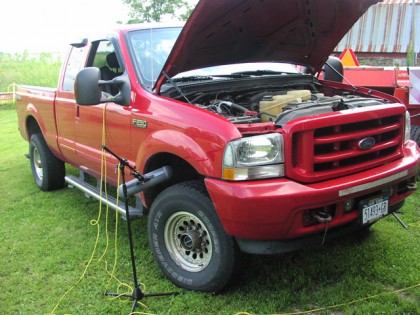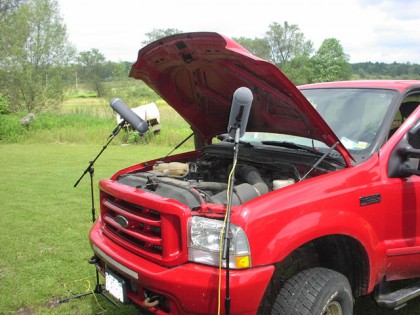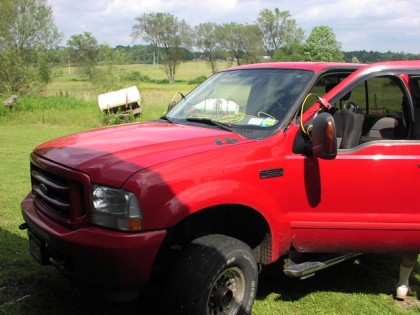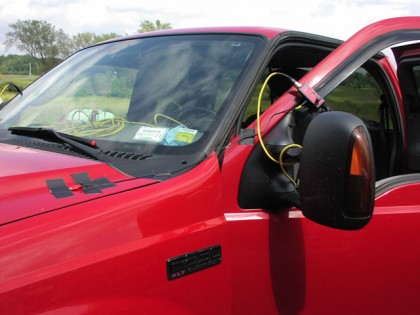Blogging Rule #723: Don’t wait 6 weeks to write about something. If you’re like me, you’ll forget interesting details.
<:-b
As discussed in an earlier post, I spent the Independence Day weekend at my parents’ farm in central NY and one of the things I wanted to capture while out there was the engine on my father’s Ford F-250 Super Duty pickup. I mentioned in that post how I have a tendency to overdo things and, given the opportunity, I would have done so with the truck with mics aimed at the engine, at the exhaust, at the wheels, in the interior, and anywhere else I could’ve come up with. But I only have 2 channels on my 702, so I’m limited in just how crazy I can get (that is, until I get a 2nd recorder, mwahahaha).
This is/was for a game audio project in which I wanted to have the engine sampled at multiple rpm’s which would then be pitched up and down and crossfaded with adjacent samples so as to smoothly cover the entire range of engine speeds.
For those who are interested: I’m out of the loop these days so maybe things have gotten more advanced, but at least when I was in high school & college, low-mid level sample-based digital pianos would do the same thing in order to save space in memory. Keyboard manufacturers would sample, for example, each ‘C’ note and would shift the pitch of that recording upwards to cover the notes C# through F immediately above that original C, and pitch the recording down for the notes G through B directly below that C. (I’m not sure if the F# was pitched up or down, since that’s right in the middle, but you get the idea). The end result is that you only have to store the recordings of one note per octave instead of twelve.
Since I only had two tracks with which to work, I couldn’t get 8 microphones on the truck and record a half-dozen different perspectives at once. My buddy Watson Wu has more experience recording cars than anyone I know, and not crappy cars either: Pagani Zonda, Porche Carerra GT, Aston Martin DBS, many Ferraris (California, F50, Enzo, and more), Lamborghini Murcielago, Shelby GT500…. And when he’s not recording supercars, he’s recording machine guns. His Facebook photo albums are insane. But anyways, since he has a fair bit of experience with sort of thing, I asked him how he would record the car if he only had two onboard mics. His recommendation was to put one on the engine and one on the exhaust.
I decided later that didn’t actually want a mono recording (which is what you’d have if you just combined the two), so I decided to try taking one pass with a stereo pair on the engine, and another pass with a mic on the exhaust w/ the extra channel to be decided on the fly (perhaps a contact mic somewhere near/on the engine compartment), and then figure out a way to sync them up after the fact. However, when I started soundchecking, I found that there wasn’t much sound coming out of the exhaust pipe at all. It turns out that on this truck (and on many Fords, from what I’m told) the bolts holding the exhaust manifold to the engine block are rusting and causing the seal to fail. This means that the sound that would normally come out of the tail pipe is now coming out of the wheel well. It also meant that I could take Watson’s advice and get both the engine and the exhaust in one shot and in stereo:
There’s another mic in the same position on the driver’s side. Here’s what it sounded like:
[jwplayer mediaid=”257″]
Next, I took another pass with the microphones pointed at the engine itself:
The audio:
[jwplayer mediaid=”256″]
Originally, I had planned on making these recordings while the truck was moving, because engines sound different when under load and accelerating, under load and decelerating, and just sitting in neutral. I wanted the real thing. I brought along a couple Latch Lake Xtra boom mic stand extenders, thinking I could mount them to the arms holding on the side-view mirrors.
I thought wrong.
The arms are too wide for the mount on the Xtra boom and even if they hadn’t been too wide, I would have still had problems. The cross-section of the arms isn’t round, it’s elliptical. Because of the way the Xtra Booms clamp on, this elliptical cross-section would have killed one of the axes of rotation that I would have needed to position the microphone, rendering the whole process futile. So the LatchLake’s went back in the suitcase and I was stuck getting the bulk of my sounds with the truck parked, in neutral.
In doing this, I learned that maintaining a steady engine speed on this truck, without any load, is incredibly difficult. In fact, the throttle was so sensitive that I couldn’t keep it steady with my feet; I had to lay down on the floor of the truck and press the accelerator pedal with my hands. I imagine this would have been easier had the truck been on a dynamometer, because the resistance would have moderated some of the finnickyness of the engine.
I did try recording the truck while out driving, but because of aforementioned mounting problems, I couldn’t use my regular microphones. Instead I used a couple of contact mics taped to the hood (or “bonnet” as some would say):
If you can’t see it well enough, here’s a closer shot:
These things aren’t marketed as “contact mics” per se; they’re drum triggers that a client left at the studio several years ago which I’d forgotten about until I stumbled upon them in a drawer the day before I left on my trip. Drum triggers and contact microphones are essentially the same thing: piezoelectric transducer elements with a preamp or impedance matching circuit. With these particular devices, the preamp is designed to clamp onto the rim of a drum, which conveniently allows it to also be clamped to those plastic shield things that keep rain from flying in your window. However, because they’re made for drums which don’t cover a lot of real estate, the attached cables are pretty short. Because of this, I had to place the transducer elements rather high up on the hood, as you can see from the pictures.
The audio:
[jwplayer mediaid=”255″]
An interesting perspective, for sure, and one that I’ll keep in mind if/when this comes up in the future. I’m pretty sure that the rattling you hear is the hood bouncing up and down as we hit bumps in the road. I never realized there was so much play in a car hood. It would, obviously, have to be secured tightly for any future attempts.
Overall, I’m happy with the quality of the recordings. The content of the audio (e.g. the engine sounds themselves) were good, but not as good as I’d hoped, though in hindsight, I suppose it was rather naive of me to think that I could hit one out of the park on my first try. As I mentioned earlier, it was very difficult to get the engine to maintain a steady speed while in neutral; this ultimately meant that I didn’t get all of the evenly-spaced incremental recordings I wanted (e.g. 1000 rpm, 1250, 1500, 1750, etc). I had to take whatever I could get. Second, when recording on the road, try to use something with a manual transmission. Because it shifts gears for you, an automatic won’t give you the consistency over time that you need. Now I understand why vehicle recordists use dynos instead of taking the cars out on the track.
For the audio nerds out there (seriously, who else would have made it this far?), the microphones were Mercenary Audio Mfg KM-69 small diaphragm cardioid condensors and the recording deck was a Sound Devices 702. I left the drum triggers at work and I don’t remember what brand they are. It doesn’t really matter, though – anything should work.




